Padbol Official Regulations
Rule No. 1: Measures of the Playing Field
The Padbol playing field has the following measures and characteristics:
1.1 The playing area will be a free rectangle of 1000 centimeters long and 600 centimeters wide (internal measurements), with a margin of no more than 8%. It will be divided transversely by a net that will prevent the passage of the ball and will allow the vision through its entire extension, suspended by a metallic cable with a maximum diameter of 1 cm, whose ends will be subject to two net posts, and its inner faces will coincide with the lateral limits of the court.
1.2 In each of the backs of the game area there will be a rear pediment and two side walls joined to it and arranged in a U-shape. Both the pediment and the side walls will have a height of 250 centimeters and must be equal to each other. When speaking of fronton and side walls, it is tempered glass, surface that does not alter or distort the essence of the game and ensure the good bounce of the ball.
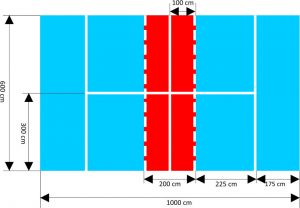
1.3 The metallic mesh may be of an artistic or rhomboidal type; in both cases the size of the opening of the mesh (measured in its diagonals) should not be less than 4.50 centimeters or more than 5.75 centimeters and should have a tension that allows the bounce of the ball on it.
1.4 Access to the playing field will be defined by 2 centered doors of 200 centimeters wide, 100 centimeters on each side of the net, by 250 centimeters high each, coinciding with the start of the upper metallic mesh. The net and the design of the same should not hinder the normal development of the game. Accesses can have a central post, extension of the net post, according to the constructive characteristics of the installation, which extends from the post that holds the net to the height of the metal mesh. (See figures). In the case of existing said post, it will work from 100 centimeters and up to 250 centimeters in height with the same rules that apply to glass walls but for both teams simultaneously.

1.5 The net must be fixed at a height of 100 centimeters constant from post to post, it must contain a strip or band of the same color with a minimum width of 6 centimeters and a maximum of 10 centimeters – equal to both sides of the net – covering the metallic cable in all its length. Regulatory measures of the net will be 600 centimeters wide and 80 centimeters high, leaving a regulatory lower light up to the floor of 20 centimeters in order to prevent players from stepping on it during the game and create inconveniences and / or injuries.
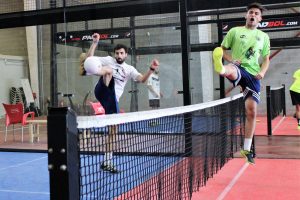
1.6 On both sides of the net and parallel to it, the service lines of 5 centimeters in width will be demarcated, starting at 325 centimeters from the net. Also, the two areas that are included between the net and the service lines will be divided exactly in half by a line perpendicular to these 5 centimeters wide and defined as the center line of service.
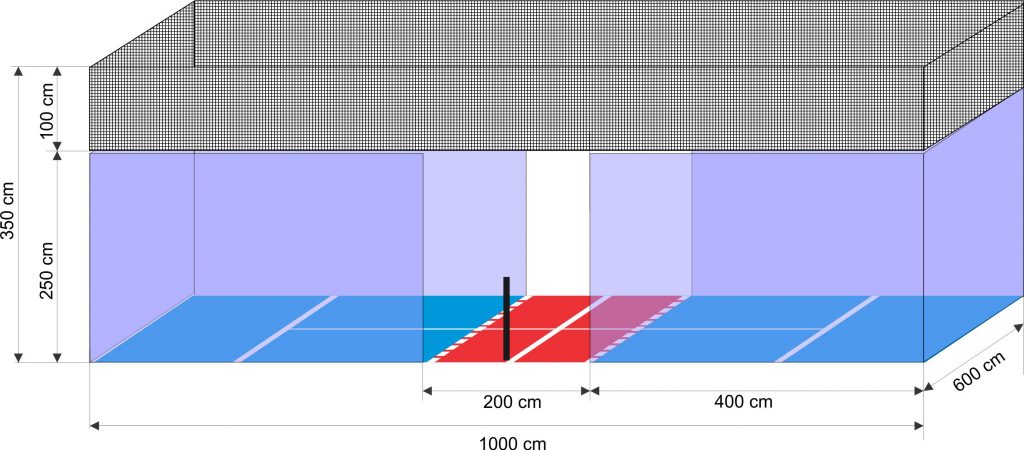
Rule N° 2: Facilities
The following will be considered as facilities of the court:
2.1 The net, side anchorage fixed to the walls or to the post that support the net, the cable holding the net, the web or strip on the top of the net, the tape or central belt, the walls, the metallic mesh (including the access door, if available), posts and/or the pillars of the net and the floor.
2.2 The following will be considered as permanent fixed objects to those which may be reached by the ball or players or which in somehow could influence the development of the game, not being part of the court itself, e.g. lighting poles and lights, the ceiling and its elements, the judge and the public, the judge’s chair and table, counting boards, or other elements.
Rule N° 3: The Ball
The ball shall have a uniform outer surface and shall be white or yellow and shows the Padbol logotype. In case it has seams, they will be without stitches. Its perimeter is of 670 mm. and shall be of a complete bounce, made in polyurethane, and its weight may vary between 330 grams to 400 grams.
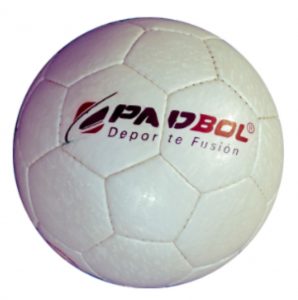
Rule N° 4: Play Zones
Service Zone – Reception Zone – Red and/or Attack Zone – Exterior Zone
Service Zone: It’s where the server should be located to perform its serves (Rule 7.1); it is bounded by the line that is at 3.25 meters from the net, the side walls and the bottom wall.
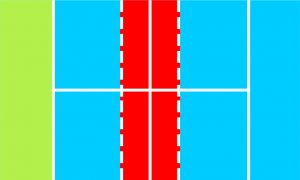
In the image can be seen the complete Service Zone of a sector. Depending on the turn server does it from the odd or even side, this area is reduced by half.
Reception Zone: It’s the area between the net, center serving line, the line that goes from side to side of the court (from its 6 meters width) and the side of glass and/or wall which close that perimeter. The lines on the floor are included.
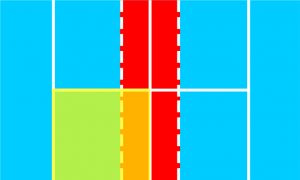
In the image, only one option is marked on one side of the receiving field in order to make it clear that the center and bottom lines are part of it.
Red and/or Attack Zone: This is the area which occupies 1 meter for each side of the net, delineated by a dashed line and in the full width of the court; this area should be differentiated unfailingly with the red color.
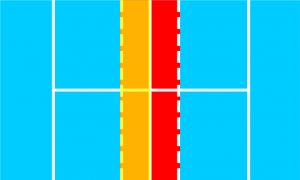
In the image can be seen the complete Attack Zone on one side.
Exterior Zone Exterior: It includes the entire exterior to the playing field delimited by the walls and in which the same rules apply as in the Red Zone and / or Attack but without being allowed the bounce on the floor, that is, the game must always be aerial. Being in that zone a player will be allowed to pass the ball to the opposite field or play with its partner in the event that they still have passes available, either by the same access zone or above the maximum height of the field of play bounded by the metal grate.
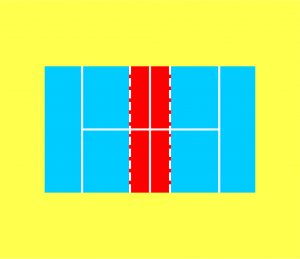
The Exterior Zone does not have particular measures and will depend on the area where the facilities are set up.
Rule N° 5: Players
Padbol is played by two teams of two players each, one couple on each side of the net. The player in charge of putting the ball into play will be “the server” and the one who should answer the first will be the “receiver”.
Rule N° 6: Toss
The choice of side and who start serving or receiving in the first game, will be decided by a toss. The couple that wins the draw may choose or request their opponent to choose:
6.1 The right to be a server or receiver, in which case the other pair will choose side.
6.2 The side, in which case the other pair will choose the right to be a server or receiver.
Rule N° 7: The Kick-Off or Service
With the service done with the foot, the ball will be in play to start each point and it will have the following characteristics:
7.1 The server shall be placed behind the service line and, as appropriate, to the left or right of the imaginary extension of the central service line towards the back wall of its field.
7.2 At the beginning of each game, the server must serve starting on the right side and then alternating between the left and right halves of its field, and always targeting its throw to the qualified area that is diagonally opposite on the opponent side.
7.3 The qualified area for the proper bounce of the ball in the receiver side will be the area between the net, the center serving line, the line that goes from side to side of the court and the side glass and/or wall which close such perimeter. The lines on the floor are included in the Service box.
7.4 The player who serves will have to bounce the ball in the same area in which is enabled to stand.
7.5 The bounce of the ball before making the throw-off must not exceed the server’s hips and at the time of the ball hit should have at least one of the feet in contact with the ground. If these conditions have not been respected the point should be repeated.
7.6 At the time that the foot touches the ball, the service is considered made.
7.7 If a serve is inadvertently executed from the wrong half as per 7.1 and 7.2, all points scored and/or service faults in such a situation will be correct and stand, but the positional error must be corrected as soon as it is discovered.
7.8 At the end of the first game, any one of the members of the couple that has just received will be the server in the second game. In the third game the partner of the first server will serve. Finally, in the fourth game, the partner of the server in the second game will serve, and then the same sequence will be repeated until the end of the set. Then, at the beginning of the next set, any one of the members of the pair to which it corresponds to serve can start the sequence according to the order of the previous stage, except as stipulated later, when a set ends in Tie Break.
7.9 If a player serves in the wrong turn according to the preceding paragraph, the player who should have served will do so as soon as the error is discovered, but all points scored before that discovery will be counted. If a game had been completed prior to that discovery, the serving order will then remain altered.
Rule N° 8: Service Fault
A service will be considered as incorrect – service fault – in the following cases:
8.1 Touching the server with a foot in any area other than that defined as permitted in rule No. 7.1.
8.2 When the server does not respect any of the specifications in Rule No. 7.
8.3 When the ball touches the ground directly outside the corresponding area, which is the same area where the server must stop to serve (7.1)
8.4 When the service exceeds, after being hit by the serving player, the height of 350 centimeters before hitting the opponent’s court, a height that coincides with the maximum height of the upper fence.
Rule N° 9: Second Service
After having committed a service fault, if it is the first at that point, the server will serve again from the same enabled zone (with the exception that the serve was made from the wrong half, in which case rule N 7 must be applied). If the server commits a new fault in front of its second service, the pair will lose the point “double fault”.
Rule N° 10: “Let” and Serve Turn
It will be considered “Let” and the point will be played again when:
10.1 The ball breaks during the game.
10.2 The game is interrupted by some unforeseen event and unrelated to the players.
10.3 The served ball touches the net, cable, side fasteners or band and then bounce in the right area and it is not a foul.
10.4 A serve, right or fault, is made when the receiver is not ready.
10.5 Every time that the judgment for let according to this rule, it shall have the following interpretations:
10.5.1 When missed on only one serve (Let), that single serve will only be replayed.
10.6 The player who during the game considers that there has been a situation that these rules qualifies as “Let”, shall immediately notify their opponents and stop the point, or risk losing the right to do so after it is completed.
Rule N° 11: Preparation of the Receiver
The server must not serve until the player that must receive is ready.
If the receiving player receives the ball and continues the point, will be considered ready and so will its teammate.
Rule N° 12: Service that Touches a Player
12.1 If after the ball served touches the receiver or its partner in their arms and/or hands before or after it has successfully bounced, the server wins the point, with the exception of the receiver’s foot, torso, leg or head in circumstances of a proper return. If the same thing happens, but after the ball has touched the net, band, cable or fastenings, then it will be a Let.
12.2 On the other hand, if the ball touches the server’s partner, the service is considered as fault.
Rule N° 13: Game Implementation
For the game implementation the following will be taken into account:
13.1 The player who puts a serve into play cannot do it before the first bounce of the ball.
13.2 The couple who receives the serve in the first game of each set shall decide which members will receive the first serve, and this member will continue to receive the first service in every odd game throughout that stage or set; similarly, the opposite couple will decide it for the first point of the second game, and this member will continue to receive the first service in each game over that stage. The members of each team will receive the serve alternately throughout each game.
13.3 If during a game the order of service reception is changed by the receivers, it will remain as altered until the end of the game in which the error is discovered, but the members of the team resume the original order of receiving in the next game of that set in which they are receivers of the service again.
Rule N° 14: Ball in Play
Once the service is delivered, the ball is in play and, unless a foul or Net, it will remain in play until the end of the point.
14.1 During this time the ball is passed alternately by one and another player of the same team to a minimum of two or for a maximum of three hits.
14.2 After the third hit the ball must be send to the rival field where the opposite team will have the same bounce and at least, the two corresponding hits and a the maximum of three.
14.3 The walls can be used to cause rebounds towards the opponent field, that is to say, any player may return the ball in one hit as long as the ball bounces against one of the side or bottom walls and after the ball has bounce into the play area as being a returning service, as in other cases this will be allowed because it is considered as volley.
14.4 It will not be considered double hit when two players try to hit the ball simultaneously, but only one succeeds.
Rule N° 15: Volley
After putting into play the service the receiving player cannot hit the ball air. From that instance the ball may be volleyed by any player and with any part of the body except arms, forearms and hands provided he is standing inside the red zone, which is the area bounded in red that is 1 meter on each side of the dividing net.
Rule N° 16: Right Return
A ball in play by the opponent shall be considered correct and the point shall continue in the following cases:
16.1 When the receiving player, after the bounce, passes the ball to its partner without it touching the ground again, the latter having the possibility of returning it to the opponent’s court or passing it back to its partner for the final touch. Only three touches and one bounce per side will be allowed. Touches can be made with all parts of the body except for the arms, forearms and hands.
16.2 Where a ball is returned after the bounce and the first touch hitting it on one of the side or bottom walls and crosses the net towards the opponent field without touching it or touching the net or the band, cable or side fasteners.
16.3 When after hitting the ball in its side of the court and after the first or second touch of its teammate, the player passes its arm or leans over the net but without jumping it.
16.4 When after hitting the ball as a result of the movement of the player in the race or by the continuity of the movement of termination of the impact made on the ball, the player touches the net or any element that is part of the structure, provided that there is no intention to lower the net or modify its height for personal benefit.
16.5 When the ball, after the first correct shot, hits one of the facilities listed in Rule No. 2.
16.6 When the ball, propelled by the rival and after its bounce, hits one or more walls and, due to its speed, returns to the center of the field of play and the player of the attacked side is in contact with the attack zone (red area) or in the air as a result of a jump and when falls makes contact with at least one of its feet with the attack zone (red area) a return with a simple touch is allowed.
Rule N° 17: Lost Point
A player – and its partner – will lose the point in the following cases:
17.1 If the ball sent after a touch bounces in the floor of the own side of the field.
17.2 If the ball, before it can be put into play, bounces for the second time on the floor of its own field.
17.3 If the ball sent hits, before the first correct shot, the walls of the opponent’s field or any portion of wire mesh in the entire field of play or the posts of the net.
17.4 If the player touches or hits the ball with its arms, forearms and / or hands. If it is touched by any of these parts of its body, it will be considered a point against it.
17.5 If a player at the moment of impacting the ball maintains an exaggerated and extensive contact with it and as a consequence manages to divert the normal trajectory of the ball, it will be judged as a “double hit”.
17.6 If the ball in play touches the player or whatever it uses or carries, except for the parts of it body enabled for that purpose.
17.7 If the player touches the net, band, cable or lateral supports net posts at the moment of impacting the ball; or the ground and wires in the opponent’s zone while developing the point.
17.8 If a player takes the air ball before it has crossed to its field.
17.9 If at the moment of impact to volley the ball the player is not in contact with the red zone or attack with feet, one foot, or just part of one foot.
17.10 If the player at the moment of impact of the volley is in full jump and falling is not in contact with the red zone or attack with both feet, or one, or part of one.
17.11 If the player takes or touches the net with its hands while the ball is in play.
17.12 If the partner of the receiver in turn crosses the field and intercepts the rival service beyond doing so within the red or attack zone.
Rule N° 18: The Ball Touches Fixed and Permanent Elements
18.1 If the ball into play touches a permanent or fixed element as the ones listed in Rule N° 2, after the right bounce, the player who sends it wins the point.
18.2 If this happens before the ball hits the ground, its opponent wins the point.
Rule N° 19: Interferences
19.1 When a player is bothered by anything beyond its control, with the exception of facilities or permanent fixed elements and of its partner, the point must be repeated (“Let”).
19.2 If a player commits any act that affects its opponent when making the hit, if this is deliberated, it will lost the point, and if this involuntary, the point shall be replayed.
Rule N° 20: Special Situation
The following statements are situations that can often occur and will be interpreted as follows:
20.1 If after the last hit of a member of a couple the ball does a regulatory bounce and then hits the net, band or belt, anchors and cable, this fact will enable any player of the opposing couple to continue the sequence of the game.
20.2 No player may jump the net during a point in game, even if it touches again the floor of the opposing field after ended the point, because if doing so it will lose that point.
20.3 The rebound in the metal mesh of the own field will be valid if previously the player pushes the ball to bounce in a glass wall first, that is to say, bouncing it in the mesh is valid in an indirect case.
20.4 A player will be able to give continuity to the game in the event that after a rival hits the ball and this, after bouncing on the floor of the defending team, was to impact directly on the metal mesh of its half of the field of game. In this exceptional case, the direct impact of the ball with the metal mesh does not mean the end of the point.
Rule N° 21: Scoring
21.1 The matches will be played for the best of 3 sets or stages, with the possibility of playing a maximum of 5 sets.
21.2 Points in a game will be counted as follows:
21.2.1 If a couple wins their first point, they get a score of 15 for that couple, when they win their second point, they get a score of 30 for that couple, by winning their third point they get a score of 40 and the fourth earned point by that couple will be counted one game or won game, except that:
21.2.2 If the couples have won three points, they will get a score of 40 equal and the next won point by a couple will be called “advantage” for that couple. If the same partners won the next point, they win the game, if the other couple wins; they will be again as “equal.” And so on until one of the couple wins the two points immediately after the equal scoring, at this point the game will be awarded.
21.3 Games in a Set or Stage:
21.3.1 The couple who first wins 6 games will be awarded the set or stage, but can only do so for a minimum difference of two games with the rival couple. If this is not so the set will last until that difference is reached by one of the couples.
21.3.2 The Tie Break system or Sudden Death may be adopted, as an alternative to define the set. The same will be used when the score set reaches 6 equal games. The couple who finally wins the set through this system will have done it with a scoreboard of 7 games against 6 of their opponents.
21.4 Tie Break or Sudden Death:
21.4.1 The couple who first wins 7 points will be awarded with the Tie Break with the condition that this happens with a difference of two points, since otherwise the count will last until one of the couples get this difference. The score in the Tie Break will be numerically consecutive (“1-0”, “2-0”, “2-1”, etc.), unlike a common game.
21.4.2 At the start of the Tie Break, the player who has to serve will be the server for the first point. From then on it the sequence of set services will go on but each player will be Server during two points.
21.4.3 From the first point, each service will be alternately sent from the right side and the left side of the field, starting from the right for the first point, left for the second one, right for the third, and so on. If a service is made from the wrong half of the court and is undetected, all the game resulting from such wrong service or services will stand, but the inaccuracy situation will be corrected immediately upon discovery.
21.4.4 Couples shall change sides every six points in the Tie Break but without the right to rest. At the end of the Tie Break they will change again sides and they can rest the regular time set out in rule 23.2.
21.4.5 The couple who serve first during the Tie Break will receive during the first game of the next set.
Rule N° 22: Field Change
Couples will change sides or fields when the sum of the set games is an odd number.
Rule N° 23: Game Continuity
The game shall be continuous from the first service until the match is over, according to the following stipulations:
23.1 If the first service is a fault, the following must be thrown without delay. The Receiver must play to the rhythm of the Server and shall be ready to receive the serve when the server is ready to serve.
23.2 In side changes the maximum time allowed by the Rules of the competition in question will run, which is 90 seconds, since the ball is out of play at the end of the game, until the moment the ball is hit for the first point of the next game.
23.3 Between points the maximum time allowed will be 30 seconds, from the moment the ball is out of play at the end of the point, to the moment the ball is hit for the next point.
23.4 The judge will use its discretion when there are interferences that make it impossible for the game to be continued, and even he may suspend or delay the game if appropriate.
23.5 The game should never be suspended, delayed or interfered with the purpose of allowing a player to recover its strength, breath or physical condition, except for accidental injury, where the judge will formally allow a suspension for a maximum of 3 minutes.
23.6 In cases of suspensions, players can warm up before restarting the game, which shall be resumed in the same conditions it was suspended, with the same score; serve sequence, position and location of the receptors in the fields.
Rule N° 24: Authorities
In those games in which a Judge and/or Referee has been chosen, its decision is final.


